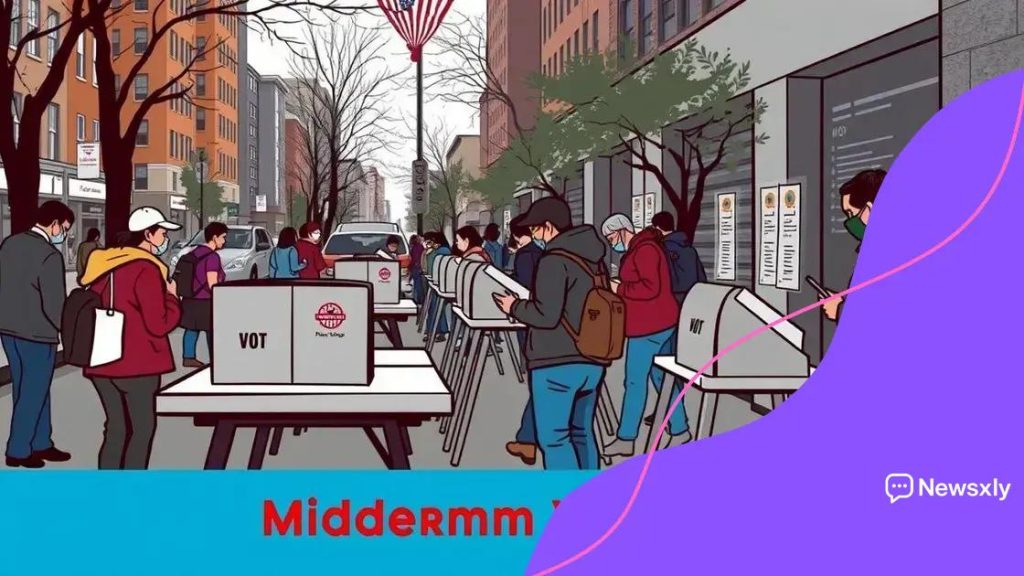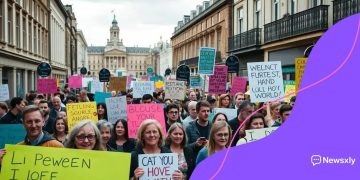Key issues in the midterm elections you shouldn’t ignore

Key issues in the midterm elections include voter rights controversies, the impact of the economy, social media influence, and candidate positions, all of which shape voter engagement and future political trends.
Key issues in the midterm elections can significantly influence voter behavior and decision-making. With varying opinions and priorities, have you considered how specific topics might affect your vote?
Key controversies surrounding voter rights
Key controversies surrounding voter rights remain at the forefront of discussions during elections. Understanding these issues is vital for every voter. Various debates have emerged over the years, highlighting the importance of making voting accessible to all.
Recent Legislation Changes
Legislation related to voting rights can vary greatly between states. Some regions have enacted laws that critics claim make it harder for certain groups to vote. This has ignited controversies about equality and fairness in the electoral process.
Voter ID Laws
One significant area of contention is voter ID laws. Advocates argue that requiring identification prevents fraud, while opponents believe these laws disproportionately affect minority groups. Here are some key points:
- Many people lack the required ID.
- Fraud incidents are rare according to studies.
- Opposition to strict ID laws is growing.
Additionally, gerrymandering remains a hot topic. This practice involves redrawing district lines to benefit one party over another, often leading to significant discrepancies in representation. Fair representation is crucial for democracy, yet gerrymandering complicates this ideal.
The Impact of Technology
As technology advances, issues like online voting and ballot security come into play. While some advocate for online voting as a means to increase participation, others raise concerns about hacking and privacy. Balancing these factors is essential for preserving voter rights.
Voter suppression tactics, such as reducing polling places, can lead to long lines and increased waiting times, thus discouraging participation. Ensuring that all citizens can make their voices heard is a core principle of democracy that must be protected.
Staying informed on these controversies is essential, especially as we approach the midterm elections. Knowing your rights and how to exercise them can empower you to participate fully in the democratic process.
Impact of the economy on midterm elections
The impact of the economy on midterm elections is significant and cannot be underestimated. Economic conditions often dictate how people feel about their government and their willingness to vote. When the economy is doing well, incumbents may enjoy higher approval ratings, which can influence the outcome of elections.
Key Economic Indicators
Several vital indicators reflect the economic climate and can sway voter opinion:
- Unemployment rate: A lower unemployment rate typically boosts voter confidence and satisfaction with the current administration.
- Inflation trends: Rising prices can lead to voter discontent, prompting calls for change.
- GDP growth: Strong growth can enhance perceptions of government effectiveness and influence the midterm elections.
Additionally, personal experiences play a crucial role in shaping voter sentiment. If people feel that their financial situations are improving, they are more likely to support the incumbent party. Alternatively, those facing economic hardships may turn to opposing candidates in hopes of change.
The Role of Campaign Strategies
Campaigns often focus heavily on economic issues, as they resonate deeply with voters. Strategies may include:
- Highlighting tax cuts or incentives aimed at small businesses.
- Addressing concerns over inflation and proposing practical solutions.
- Showcasing job creation efforts and economic recovery plans.
For candidates, it’s essential to communicate a clear understanding of economic challenges and potential solutions. Voters are looking for reassurance that their leaders can navigate economic uncertainties effectively. With this understanding, candidates can create compelling narratives that align with their audience’s experiences and concerns.
The relationship between the economy and midterm elections is intertwined. As changes occur in various economic aspects, so too will the political landscape, affecting how voters perceive their leaders and the choices they make at the polls.
Role of social media in shaping opinions

The role of social media in shaping opinions has become increasingly prominent, especially during election cycles. Platforms like Facebook, Twitter, and Instagram play a crucial part in how information is shared and consumed. Voters today often turn to social media for news, updates, and insights about candidates and issues.
Influencing Public Perception
Social media has a powerful influence on public perception. A single post can go viral, impacting how candidates are viewed. This influence is largely due to:
- Accessibility: Information spreads quickly and reaches a broad audience.
- Engagement: Users can directly interact with content, leading to discussions and debates.
- Real-time updates: Candidates can share their views and respond to events as they happen.
These factors contribute to shaping voter opinions and mobilizing support. Social media not only informs voters but also creates communities around shared beliefs and values. Many users align themselves with specific social media pages or follow influencers who endorse candidates.
The Risks of Misinformation
While social media can enhance political engagement, it also poses risks. Misinformation can spread quickly, leading to confusion and mistrust. Here are key points to consider:
- Fake news stories may affect public perceptions.
- Share buttons can amplify false information.
- Users may find it challenging to distinguish between fact and opinion.
As users navigate their feeds, they must remain vigilant about the information they consume. Critical thinking becomes essential to identify credible sources and verify facts. Furthermore, candidates and their campaigns often utilize social media for targeted advertising, allowing them to reach specific demographics effectively. Understanding these strategies can help voters become more informed participants in the electoral process.
Ultimately, social media serves as both a tool for empowerment and a source of potential pitfalls. Voters are encouraged to harness the positive aspects while remaining cautious about misinformation that can sway opinions unjustly.
Analyses of key candidates and their positions
Analyses of key candidates and their positions are essential for voters as they prepare for the upcoming elections. Understanding where candidates stand on important issues allows citizens to make informed choices. Each candidate may have different priorities that appeal to various segments of the population.
Key Policy Areas
When analyzing candidates, it is crucial to look at their positions on key policy areas that typically influence voter decisions:
- Healthcare: Candidates often debate healthcare reform, from universal coverage to employer-based options.
- Education: Education policy can vary, with some advocating for increased funding in public schools while others support school choice.
- Climate Change: The approach to climate policies can determine how candidates plan to deal with environmental issues.
- Economy: Candidates may have different views on taxation, government spending, and job creation strategies.
Understanding these positions helps voters assess which candidates align with their values and priorities. Evaluating the candidates requires examining their track records and proposed policies. Often, candidates provide detailed plans on their campaign websites.
Debate Performance and Public Perception
The performance of candidates in debates can significantly shape public perception. A strong debate showing can boost a candidate’s visibility and support. Interesting aspects to consider include:
- How candidates respond to tough questions.
- Their ability to connect on personal levels with the audience.
- Whether they provide clear and actionable solutions.
Furthermore, public perception often shifts based on how candidates handle crises or controversial topics. As voters analyze candidates, social media platforms can impact how debates are perceived and discussed. Engaging with constituents through these platforms allows candidates to share their views and respond to concerns in real-time, making it easier for voters to stay informed.
Ultimately, a thoughtful analysis of candidates and their positions on key issues can empower voters, helping them to make decisions that reflect their beliefs and priorities as the election approaches.
Future trends after the midterm elections
The future trends after the midterm elections promise to shape the political landscape in significant ways. Understanding these trends helps voters anticipate potential changes and the implications for government policy. Various factors will influence the direction of politics in the coming years.
Shifts in Voter Demographics
One notable trend is the changing demographics of the electorate. Younger generations are becoming more active in politics, often prioritizing issues like climate change and social justice. This shift can lead to a push for policies that align with their values.
Increased Voter Engagement
Voter turnout has been growing in recent elections, reflecting greater civic engagement. Many initiatives aimed at encouraging participation have proven effective. Consider the following elements:
- Grassroots movements: Local organizations are mobilizing voters and fostering community involvement.
- Social media campaigns: Platforms are being used to raise awareness about voting rights and encourage participation.
- Lowering barriers: Efforts to simplify voter registration processes are increasing access to the polls.
This increased engagement indicates a shift toward a more participatory democracy, with citizens becoming more involved in political discussions.
Policy Changes and Legislative Focus
Policy priorities may also change significantly based on the election outcomes. Candidates often campaign on key issues, and once elected, they tend to focus on delivering promised reforms. Major areas likely to see change include:
- Healthcare reforms: Ongoing discussions may lead to changes in healthcare access and affordability.
- Economic policies: The post-election environment may shift focus towards economic recovery plans in response to voter concerns.
- Environmental regulations: Climate change may drive policy initiatives aimed at sustainability and cleaner energy.
Additionally, cooperation between parties could become more essential as the electorate demands action on pressing issues. Bipartisan efforts may be necessary to achieve consensus on critical policies.
In summary, the midterm elections are likely to set the stage for future trends that influence political dynamics. Observing these trends will be vital for voters as they navigate the evolving political landscape.
The midterm elections are an important time for voters to reflect on candidates and their positions. By analyzing key issues and understanding the impact of the economy and social media, voters can make informed choices. As new trends emerge after the elections, it will be essential to stay engaged and aware of how these changes affect the political landscape. Empowered citizens can drive meaningful conversations and hold elected officials accountable to their commitments.
FAQ – Frequently Asked Questions about Midterm Elections
How do midterm elections impact voter engagement?
Midterm elections often see increased voter engagement as citizens feel their voices matter in shaping government policies.
What role does social media play in these elections?
Social media plays a crucial role by influencing public opinion and mobilizing voters through campaigns and discussions.
Why are candidate positions important?
Understanding candidate positions helps voters make informed decisions that align with their values and priorities.
What future trends should we expect after the elections?
Expect shifts in demographics, increased engagement, and potential changes in policy areas like healthcare and climate change.





